Valencia brightened with daylight, and we woke feeling great. Sunshine streamed through the tall window in our room. The hotel offered to sell us access to its breakfast buffet...
... but we decided to eat at local places as much as possible. We revisited the Mercado de Colón to see it illuminated with sunlight, and it was beautiful.
As we used the streets, we instantly noticed huge differences from New York City. Cyclists and pedestrians moved in orderly ways, drivers behaved decently, the engines were nearly-silent, and nobody honked their horns. During our three days in Valencia, we never heard an angry car horn! Coming from America, that seemed miraculous. We never saw traffic jams or congestion during commuting hours. We never saw aggressive driving, and we never saw motorbikes driven illegally on the sidewalks. Pedestrians usually avoided jaywalking and crossed the street at crosswalks, and they paused until traffic signals told them to go. It was a joy to move in an orderly society.
We heard a trio of musicians playing jazz in the style of Stephane Grappelli, with a violin and two guitars. Please enjoy my video of it...
Our joyful walking took us to the central market: Mercado Central. It’s the largest food market in Europe, and it's wrapped in Art Nouveau splendor from 1914!
The only sit-down eatery was Central Bar. Luckily, we snagged two stools at its counter before a long queue formed. (A very long queue that existed for the 30 minutes that we were there!)
It is operated by Chef Ricard Camarena, who works at a two-Michelin-starred restaurant in the city that he named for himself.
Lewis was eager to have grilled giant prawns—despite their high cost: 25 Euros for four. (At that price, the Rosewood Hotel in Madrid was a better value). At least the seafood at the coastal city was tasty. Our fresh-made sangria was mixed with locally-harvested red wine, marinated fruit, Cointreau, Hendrick’s gin, and locally-made vermouth. We also ate chargrilled squid, four chicken croquettes, and four razor clams. Those were excellent. Our meal totaled €91.20.
The mercado is near the city's Red Light District on Calle de Viana, but we didn't go there.
We proceeded to the old Silk Hall (La Lonja de la Seda), which is a UNESCO World Heritage Site.
Construction began in 1482, and the mighty hall signified the affluence that Valencia achieved. It was a stock market for the Silk Trade, and it generated tons of money because silks were carried—laboriously at great expense—from China (on the other side of the world). Admission was free with our Valencia Visitor Passes.
The courtyard had a burbling fountain encircled by citrus trees.
The walls were festooned with gruesome gargoyles, and some of those mythological creatures were used as drainage spouts.
We entered a splendid chamber that was enhanced with a wooden coffered ceiling. Great intricacy! It was built for the Maritime Merchant Tribunal.
We crossed the courtyard and ascended stone steps to the second level, where "executives" and magistrates had meetings.
Wooden shutters could seal the room, yet the windows allowed the ceiling's gilded beams and corbels to glimmer! Very pretty.
We discerned faces and figures carved into them. Please enjoy Lewis' close-up video...
The building signifies the Golden Age for Valencia. Alas, that era ended catastrophically. In 1609, King Philip III decreed that descendants of Spain’s Muslim population (Moriscos) must be banished because Catholicism was intolerant of other religions. It happened with severity in Valencia because the Archbishop of Valencia considered them as heretics and traitors. The uncaring Spaniards didn’t realize that the people they expelled were the bulk of the workers/peasantry. Therefore, Valencia caused its own economic collapse, which was worsened by the Bubonic Plague that arrived within three years. Without a sufficient population to get work done, the Crown’s expulsion was disastrous.
We attempted to have lunch at a family-run paella restaurant named La Riua. Long ago, it won awards for its food. But it was the rudest experience that we had in a long time. We arrived and said "Hola" to an employee, who merely told us to go inside and wait to be seated.
An old woman with a sour expression was looking at papers on the counter. She knew we were there, but she didn't make any effort to acknowledge us. After a few moments, I took a step forward, and she glanced up with a curt gesture and said, "One moment". Without any more effort, she looked at her papers again. Old/fat waiters came and went, and they glanced at us but averted their eyes and ignored us. After three minutes of standing there, Lewis got offended and approached her to ask where the lavatories were? With a pinched-mouth expression, the old woman looked up as if he asked her an absurd question. With a flick of her wrist, she silently indicated that they were upstairs. While he was gone, nobody tried to assist me. By the time he returned, the woman decided to give us seats at a table. We sat in our chairs, but we didn't get menus... or water. Yet, Lewis was still interested to try their paella. But after two minutes of isolation at our table, he got annoyed and said, "Forget this place. Let's leave." I agreed. The woman looked astonished that we didn't endure her rudeness, but we walked past her, and I mouthed an expletive to her rotten-looking face.
It was better that we ate elsewhere, and we immediately found a perfect place. We were in that area to visit a national landmark: the palace of a marquis from the 1700s. Nowadays, it is the National Museum of Ceramic Art. It is entirely preserved.
Due to Spain's "afternoon break" (not a siesta), the museum was closed for an hour. Luckily, we saw a spiffy cafe that was directly across from it! It was aptly named El Marquis, and it was part of the four-star SH Ingles Boutique Hotel.
Both buildings are on a street named for the Marquis of the Two Waters, who built the palace. We sat indoors at a table by the window, and we were thrilled with the view of the old palace!
Conditioned to the marked-up prices in American hotels, we expected the food to be expensive because it was in a hotel—and also pricey because there was a beautiful view of a famous landmark. Not in Spain.
We were astonished that the restaurant in an upscale hotel offered an affordable price-fixe lunch menu: €19 for 3 courses. That rarely happens in New York; hotel eateries automatically overcharge by tripling normal prices of food, and if there is a "deal", it is garbage-quality food. Both of us chose from that menu, and we added some extra appetizers. We ate Smoked Potato Salad, Smoked Salmon in Wafer Sandwiches, Fish Tacos, Chicken Samosas, "Seafood Paella For Two", and bottled water. Lewis also drank an Aperol Spritz, and I had two glasses of different locally-made Valencian white wines: a Verdejo and an Albariño (similar to Viognier). As vacationers, it's fun to sip wine at midday. In fact, a Mercedes van delivered more wine while we were there. Great timing.
I coordinated with our waiter to taste the most-popular Albariño that was delivered (it was from Galicia). If the locals like something, it's smart to try it, too.
Everything was great!
The flavorful paella had the proper thinness in the pan. Success!
Our lovely lunch cost €75.70, including a 10% gratuity. Our server was a polite Valencian man. He was training a new waiter, and we admired how that fellow earnestly did his best and behaved professionally. In the middle of our meal, our waiter inquired about our itinerary in his hometown, and he was impressed with it. When I asked for his recommendations for great coffeeshops, he suggested Cafe de las Horas. It was a sidewalk cafe with a lush interior. I assured him that we would visit it. (It was excellent, and I'll show you later).
We were grateful for all of that. Best of all, our meal occurred with a charming view!
In fact, I amused myself taking pictures of the various folks who posed for photos in front of the palace. It appeals to all types.
Entering the palace was free with our Visitor Passes. Built it outlandish Rococo style, it has quite a history. In the 1400s, a noble knight, Fon Francisco Perellos, married a wealthy heiress.
In 1496, they bought a barony named Dosaigues (Dos Aguas). In 1699, the baron was elevated to a marquis by King Charles II. The Marquis of Dos Aguas and his noble descendants lived in Valencia for centuries as prosperous merchants who married local aristocrats. The palace of the marquisate began in the 1400s as a Gothic building. In the 1700s, it underwent a metamorphosis that was funded by the third marquis (born in 1706) to proclaim the family's wealth and status.
The noble family may not live there anymore, but plenty of nobles live in Spain: 2,237 noblemen and noblewomen. Some titles are hereditary. The creation of noble titles is legally the prerogative of the King, as the head of the nobility. His Majesty enjoys ennobling citizens who provide public services, generate huge artistic contributions, donate handsomely to philanthropy, and make strides that benefit his kingdom. Unlike the nobility in the Netherlands, Spain’s may be elevated to the status of an aristocrat: a noble person with legal influence in society. In Spain, a person like that is titled as a Grandee. Until 1984, Grandees had diplomatic immunity. There are 417 Grandees, including 153 dukedoms, 142 marquessates, 108 counties, 2 viscounties, and 2 baronies. Yes, those things still exist. *To see when we explored a barony in England, please use this link: https://halfwindsorfullthrottle.blogspot.com/2021/10/our-trip-to-london-part-3-culinary.html
If you travel around Spain, you might encounter people who are known as the 19th Count of Altamira (the first was in 1475), the 12th Lady of Casa Rubianes (the first was in 1535), the 19th Marquess of los Velez (the first was in 1507), the 5th Marchioness of Silvela (the first was in 1915), the 15th Marquis of Estepa (the first was in 1565), the 5th Duke of la Torre (the first was in 1862), the 2nd Duchess of Suarez (the first was in 1981), Princess Victoria of Hohenlohe-Langenburg, or the 22nd Duke of Medina Sidonia (the first was in 1380). Nowadays, prominent families of nobility maintain their urban palaces and countryside estates with careers as jockeys, horse breeders, advisors at cultural institutions, Olympic athletes, lawyers, parliamentarians, vineyard owners, professors at the Diplomatic School, and actors.
The street-level part of the palace showcased the family's historic carriages, coaches, and a man-carried sedan chair.
The gold coach was handmade in 1753, and its suspension relies on leather straps. It was modeled on the Golden Coach used by the Prince of Liechtenstein (whose descendent is still the sovereign prince of that nation).
A grand staircase led us up to the salons, Chinese tearoom (with silk wall coverings), Porcelain Room, dining room, kitchen, ballroom, chapel, bed chambers, and drawing rooms. Upper levels were renovated as exhibits of nationwide ceramics.
Here is Lewis' video of the Porcelain Room...
Here is my video of the ballroom!
Despite the nudist classicism and erotic artwork, the constraints of etiquette created furniture that kept couples apart.
Next, we explored the Cathedral, which is an amalgamation of architectural styles, from Romanesque to Gothic to Renaissance to Baroque to Neoclassical. Its origins began in 1262.
When we entered, we noticed that the windowpanes were made of translucent alabaster, which was unusual. Towards the back, there are classic stained glass windows.
On the right, we entered the Chapel of the Holy Chalice. Supposedly, the cup dates from the era when Jesus Christ was alive. We were more interested in its ornate stonework and glittering stained glass windows. We noticed chains hung on the wall, which were "trophies" from a war against Marseilles.
Behind the altar is an unusual reliquary that claims to have part of the arm that belonged to a martyr named San Vicente who was tortured and broken apart. We avoided that grotesque thing.
Near the altar, Baroque-era frescoes adorn the ceiling, and an arched ceiling leads to a pretty stained glass window. Overhead, an eight-sided dome illuminates everything.
Please enjoy my video of it...
The permitter was dotted with various shrines and chapels. Here is my video of them...
It reminded me that the Roman Catholic Church wanted to be the supreme religion, so it developed a recruitment tactic of renaming the deities of polytheistic religions. Christianity says that there is only one god to worship, yet its believers can still worship and venerate an assortment of saints, prophets, angels, archangels, and a vague magical thing named the Holy Spirit. Those were the former gods and goddesses of other religions. Believers can also pray to apostles.
Remembering that we didn't have opportunities to ascend the church towers in Florence or Dublin (prior trips), we wanted to ascend the cathedral's Miguelete (Little Michael) Tower, which is the city's emblematic tower.
It is named for its largest bell. The Gothic bell-tower was erected in 1381, and it provides the tallest view in the city. It has an octagonal shape. A separate fee of €2 each got us access. Lewis and I climbed 207 steps! A traffic-light system lets visitors go up or come down, because there isn't space for two people to pass. Upward and onward!
Lewis' Valentino sneakers were great for the climb :-)
As we curled around the spiral staircase, we glimpsed into a hollow part of the tower that was behind bars. It was built as the church's prison and asylum. (That's why it exuded unpleasant vibes). Near the top, we peered in at the belfry from 1660: seven large bells dangle in front of seven windows (with louvres), and the last window was used for a look-out. The oldest bell is from 1305! The "newest" is an antique from 1735. They still ring!
An announcement told us that we had to wait 10 minutes until the traffic light allowed us to descend, so we invested the time admiring the view! Here is our panoramic video...
After we got down to Earth, we realized that we were within proximity to Cafe De Camilo, so we returned for more €1.10 espressos. Perfection again!
Lewis and I decided to use the remaining daylight to venture across the riverbed and visit the Museum of Arts. On our way, we peeked inside the Real Iglesia (Royal Church) del Salvador. It was in the midst of hosting a Sexual Education class. Yet, the intimidating doorway looked more like a prison cell.
We walked across a vehicular bridge decorated with statues, named Pont de la Trinitat. It was constructed in 1402, as Spain conquered the Canary Islands. That's incredible preservation.
We walked to the Museum of Belle Arts, which is the third-largest in Spain. Admission was free with our Visitor Cards. There was a lot of religious artwork because Spaniards endured centuries when the only entity rich enough to commission art was the Catholic Church (and it pressured wealthy people to do the same). Below is the domed lobby which connects to an open courtyard with burbling fountain.
Evening draped darkness over the city, and we left the museum. It was a comfy starlit night, so we decided to walk along the northern side of the park to return to our hotel. Alongside the museum is the site of the former royal palace. It was built in the Middle Ages, but it was demolished in 1810 to prevent Napoleon's troops from occupying it. The royal property is now a public park. Across from it, a bridge to the city-center was named Royal Bridge.
Once again, we admired the efficiency of the bike lanes to ease the flow of traffic during the Commuting Hours, while protecting cyclists from traffic. Great infrastructure.
Despite more money than any other city in the USA, safe bike paths still don't exist in NYC...
That is appalling because NYC has the worst traffic congestion, so bike paths are needed the most. But NYC doesn't care.
At night, Turia Park is renown as a cruising area for gay and straight people seeking hookups/quickies. Only the paths and football fields are lit, so there are plenty of secluded bushes that provide privacy. The area between the Royal Bridge and Exposition Bridge is the most active. That's where we went.
We had to cross Exposition Bridge to get to our hotel.
We dined at a Japanese restaurant nearby, Ryukishin Canovas Ramen, but it was unimpressive, and we doubt its authenticity. We ate appetizers (shrimp tempura and fried meat roll) and added marinated eggs to our Steak Ramen. The bill was €49.40, and we had no intention of leaving a gratuity.
We passed a fancifully-decorated Vietnamese restaurant named Rio, and we spontaneously entered. It was already festively decorated for Christmas.
A young husband and wife were gracious and hospitable. Years ago, they emigrated from Vietnam, and they did their own decorating and hired talented cooks. The bi-level place was half-full of content customers. The aromas wafting from the kitchen kickstarted our appetites. (The fact that we walked 6 miles helped, too). The food was classically perfect, and the service was endearing. We ordered Noodle Salad with Shrimp, a traditional Banh Mi (made properly on a toasted baguette with pork, pate, pickled carrots, and cilantro), and two Shrimp Spring Rolls. We drank tap water.
The cost was €27.00, and no tip was desired. We recommend that cheery place!
Abiding by the local habit, we went for "after-dinner food" at the Mercado de Colón. We visited a dessert bar named Daniel, and we bought horchata and fartons to eat in our hotel.
We enjoyed watching Spanish television channels: comedies, contests, cooking segments, and dramas. One channel specialized in music videos. As expected, many were American (focused on money and flashy cars), but the Spanish ones had a vivacity and happiness that we don't see in most American ones.
There was a reoccurring TV commercial for a realty company. Instead of using American-style gimmicks of "Buy Now", "Hurry", and "Limited Time Offer", it had non-intrusive images and a catchy theme-song! Here it is...
Other notable things on TV were gay-friendly music-videos.
They put us in a good mood for bedtime! :-) Please join us for the finale!








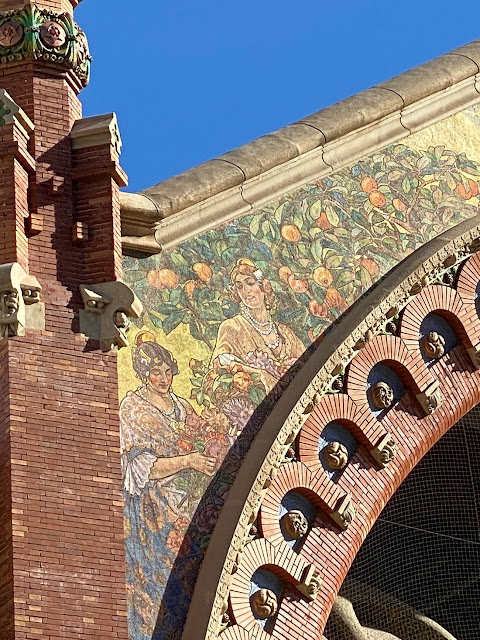








































































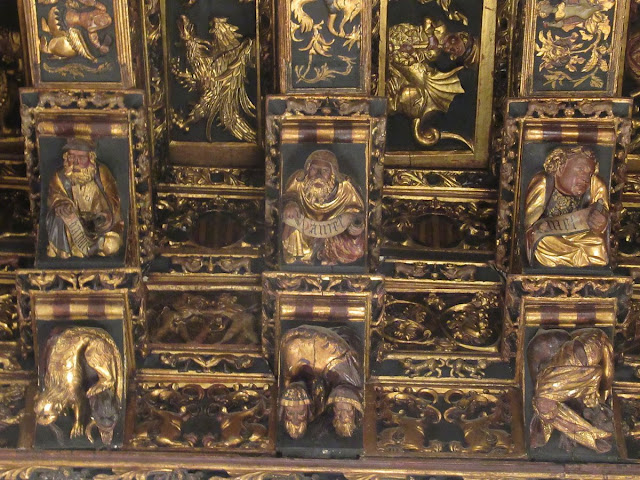

























































































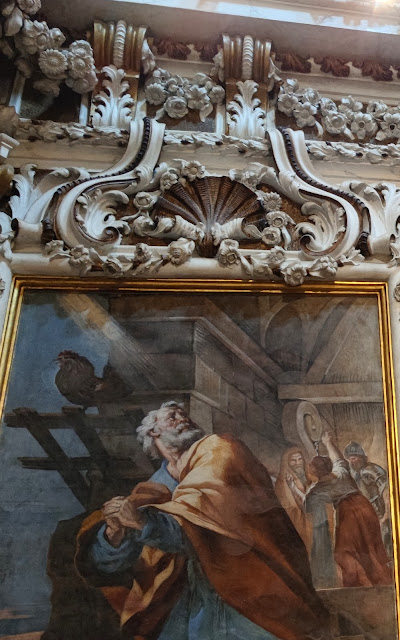







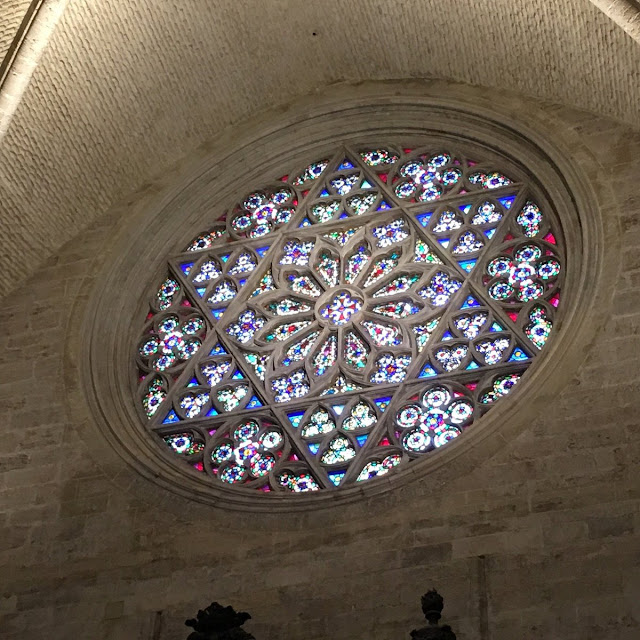




























































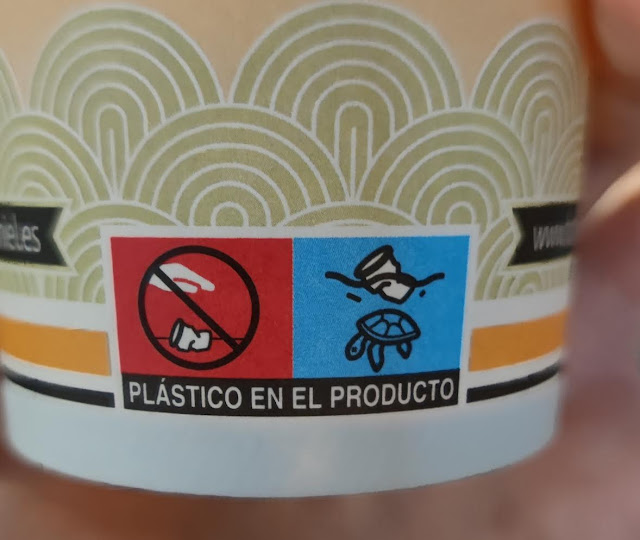






















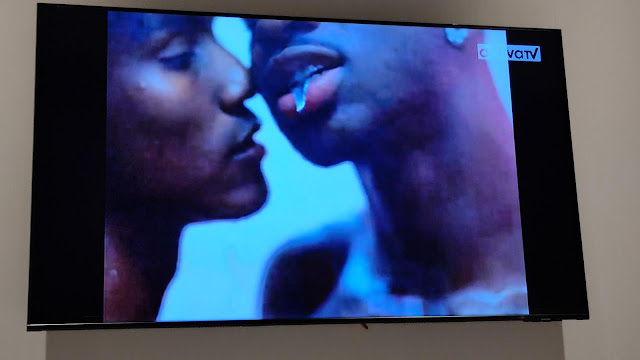
No comments:
Post a Comment
Don't be shy: leave your comments :)